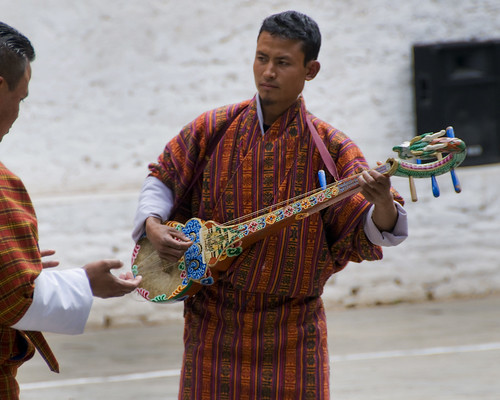Traditional folk music in Bhutan uses three main
instruments: the lingm, the dramyen, and the chiwang. The lingm is a type of six-holed
flute that actually has two varieties: dong lingm (which is played in front
like a clarinet and about as long as one too) and the zur lingm (which is
played to the side). The lingm is native to Bhutan.
The dramyen is a type of seven-stringed lute with a long
fretless neck. It’s used a lot in religious music and ceremonial music, as well
as in folk music. It’s played by plucking and strumming the strings. Although
it may be strummed, it’s mostly played one note at a time as a melody line.
The chiwang is a type of two-stringed fiddle that more than
likely was brought over from neighboring Tibet. In folk music, the chiwang is
often associated with the horse.
There are several types of folk music, but the two main
types are zhungdra and boedra. Zhungdra is often considered secular, but often
the subject matter has Buddhist overtones to it. Boedra often includes the chiwang,
and developed from Tibetan court music. A lot of religious music is chanted and
not heard much by the general public. The lyrics tend to be stories about the
lives of religious figures in Buddhism.
In the late 1960s, the genre known as rigsar became very
popular. It has a more upbeat tempo, more local and vernacular language styles,
and utilizes electronic instruments and synthesizers. And actually, they
created what became the 15-string rigsar dranyen which has two bridges. The first rigsar songs grew out of the
Bollywood songs of neighboring India, and the first actual rigsar star was
Shera Lhindup with the top song “Jyalam Jyalam Gi Ashi” in 1981. However,
popularity began to wane in the late 1980s. After some ups and downs, rigsar
music had a transformation and expanded itself to use its influences of
English-language pop, Indian pop, and Nepalese music.
Music and dance go hand in hand. A set of dances called zhey
and zhem are often danced at tsuchus (festivals). It’s actually considered a
choreographed vocal performance, utilizing both styles of folk music mentioned
earlier (zhungdra and boedra). The zhey dance is performed by men and is a
little quicker of a dance, while the women dance the zhem with more flowing and
fluid moves. Originally, dancers would dance barefoot without any particular
costume, but only in the past 40 years or so did the dancers start wearing long
gowns, headgear and the traditional boots. During the royal wedding last year,
several dance troops danced traditional zheys, representing various regions of
the country.
[And congrats to myself: this is my 100th post! Thanks for reading; it only gets better.]
Up next: the food!


No comments:
Post a Comment